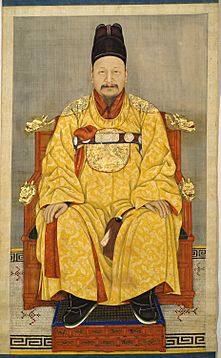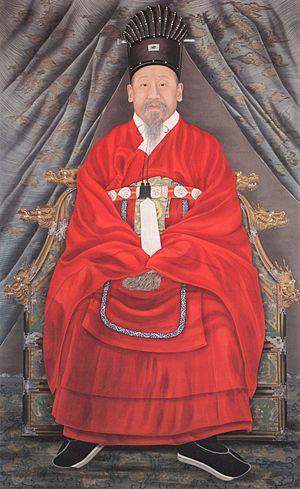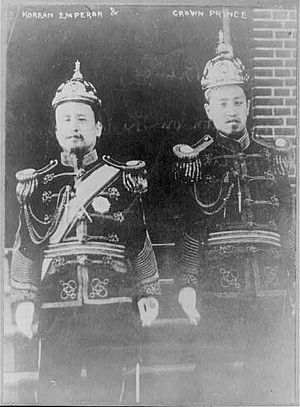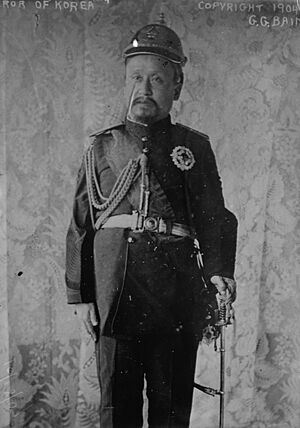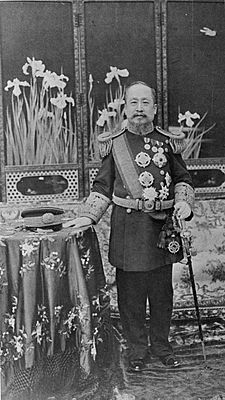Gojong of Korea facts for kids
Quick facts for kids Gojong of Korea대한제국 고종 大韓帝國高宗 |
|||||||||||||
|---|---|---|---|---|---|---|---|---|---|---|---|---|---|
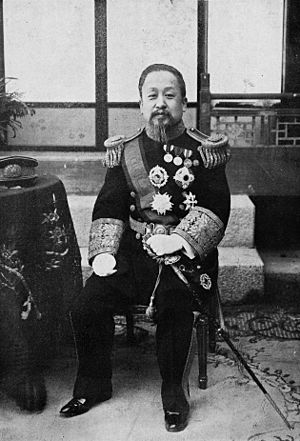 |
|||||||||||||
| Emperor Emeritus of Korea | |||||||||||||
| Reign | 20 July 1907 – 29 August 1910 | ||||||||||||
| Predecessor | Position Established | ||||||||||||
| Successor | Monarchy abolished | ||||||||||||
| Emperor of Korea | |||||||||||||
| Reign | 13 October 1897 – 19 July 1907 | ||||||||||||
| Predecessor | Himself as the king of Joseon | ||||||||||||
| Successor | Sunjong | ||||||||||||
| King of Joseon | |||||||||||||
| Reign | 16 January 1864 – 13 October 1897 | ||||||||||||
| Predecessor | Cheoljong | ||||||||||||
| Successor | As the Emperor of Korea | ||||||||||||
| Regents | Queen Sinjeong (1864–1866) Heungseon Daewongun (de facto) (1864–1873) Queen Myeongseong (de facto) (1873–1894) |
||||||||||||
| Born | 8 September 1852 Unhyeon Palace, Hanseong, Joseon |
||||||||||||
| Died | 21 January 1919 (aged 66) Deoksu Palace, Keijō, Japanese Korea |
||||||||||||
| Burial | Hongneung | ||||||||||||
| Spouse | Empress Myeongseong | ||||||||||||
| Issue | Emperor Sunjong Prince Imperial Ui Crown Prince Euimin Princess Deokhye |
||||||||||||
|
|||||||||||||
| House | House of Yi | ||||||||||||
| Father | Heungseon Daewongun | ||||||||||||
| Mother | Grand Internal Princess Consort Sunmok of the Yeoheung Min clan | ||||||||||||
| Religion | Confucianism | ||||||||||||
| Signature |  |
||||||||||||
| Korean name | |
| Hangul | |
|---|---|
| Hanja | |
| Revised Romanization | Gojong Gwangmuje (short Gojong) |
| McCune–Reischauer | Kojong Kwangmuje (short Kojong) |
| Birth name | |
| Hangul |
이명복, later 이희
|
| Hanja |
李命福, later 李㷩
|
| Revised Romanization | I Myeong(-)bok, later I Hui |
| McCune–Reischauer | Yi Myŏngbok, later Yi Hŭi |
Gojong (Korean: 고종; Hanja: 高宗; RR: Gojong; MR: Kojong; 8 September 1852 – 21 January 1919) was a very important leader in Korea's history. He was the monarch from 1864 to 1907. He started as the last King of Joseon and then became the first Emperor of Korea. He was forced to give up his throne in 1907. People also knew him as the Gwangmu Emperor (Korean: 광무제; Hanja: 光武帝; RR: Gwangmuje; MR: Kwangmuje).
Gojong had to sign the Treaty of Ganghwa in 1876. This was an unequal treaty that gave Japan many advantages. It eventually led to Japan taking control of Korea. In 1895, his wife, Queen Min, was sadly killed by Japanese agents. This made Gojong dislike Japan even more. In 1897, Gojong declared Korea an empire. This meant Korea was no longer under the influence of the Qing dynasty of China. He worked on reforms to improve the military, economy, and education in Korea. Gojong faced many challenges, including attempts to remove him from power. He died in the Deoksugung Palace, and some people believed he was poisoned.
Gojong's Life Story
Growing Up
Gojong was born in Hanseong, which is now Seoul. His father was Yi Ha-eung. When the previous king, Cheoljong of Joseon, died without a son, Gojong was chosen to be the next king. He became Prince Ik-seon just before his coronation. He moved into the palace on 9 December 1863. His parents were given special titles.
Becoming King
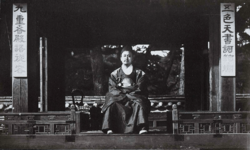
On 13 December 1863, Gojong became king at Changdeokgung palace. He was only twelve years old at the time. Queen Sinjeong acted as a regent, meaning she ruled for him until he was old enough. His father, Prince Heungseon Daewongun, helped Queen Sinjeong. In 1866, Queen Sinjeong said Gojong was ready to rule on his own. On 6 March 1866, Lady Min was chosen to be his queen. Even after Gojong started ruling, his father still tried to control things.
In the 1860s, Gojong's father wanted Korea to stay isolated from other countries. He also persecuted Catholics, which led to attacks from France and the United States. During this time, they also worked to rebuild the Gyeongbok Palace. This was the main royal palace.
In 1873, Gojong announced that he would rule directly. In November 1874, his father retired. Gojong's wife, Queen Min, and her family then gained full control of the court. They put their family members in important government jobs. Gojong tried to make the king's power stronger. He gave important jobs to his wife's relatives and other royal family members.
Challenges from Other Countries
In the 1800s, there was a lot of tension between China and Japan. This led to the First Sino-Japanese War in 1894–1895. Much of this war happened in Korea. Japan had new military technology from the West. They won a battle against Korean forces at Ganghwa Island. This forced Korea to sign the Treaty of Ganghwa in 1876. Japan started taking Korea's natural resources like fish and iron. They also gained a strong economic presence. These events made Gojong dislike the Japanese Empire.
The Treaty of Ganghwa was the first unequal treaty Korea signed with another country. It allowed Japanese citizens in Korea to be judged by Japanese laws, not Korean laws. It also forced Korea to open three ports for trade: Busan, Incheon, and Wonsan. This treaty made Korea vulnerable to other powerful countries. It set the stage for Japan to eventually take over Korea.
Rebellions and Coups
King Gojong started a new army with modern rifles. These soldiers were paid, but the old army had not been paid for 13 months. The old army became very angry and started a riot. Gojong's father, the Daewongun, took power again. Queen Min asked China for military help. China sent about 3,000 soldiers to Seoul. They captured the Daewongun, and Queen Min's family got their power back.
During this time, a court lady named Lady Seon-yeong showed great loyalty to King Gojong. He rewarded her by giving her a high rank.
On 4 December 1884, a group of revolutionaries tried to take control. They wanted to remove the Chinese army from Korea. This attempt, called the Gapsin Coup, failed after only three days. Some leaders fled to Japan, while others were executed.
Farmer Protests
In the 19th century, many people in Joseon were very poor. There was a lot of hunger and people lived in bad conditions. High taxes and corruption also caused problems. This led to many farmer revolts.
In 1894, the Donghak Peasant Revolution began. It was a movement against the government, the rich landowners, and foreign influence. One big reason for the revolt was the tax system set up by Queen Min. Gojong asked China and Japan for help to stop the revolution. Some people even tried to assassinate Gojong, but their plan was discovered. The revolution failed, but many of the farmers' complaints were later addressed by the Gabo Reform. One important reform in 1894 was ending the slave system, which had existed for a very long time in Korea.
The Sad Story of Queen Min
In 1895, Queen Min was assassinated by Japanese agents. The Japanese minister to Korea, Miura Gorō, planned her assassination. Japanese agents entered Gyeongbokgung palace, which was guarded by Korean soldiers who supported Japan. The queen was killed inside the palace. She had been trying to stop Japan from interfering in Korea. She was even thinking about asking Russia or China for help.
Growing Unrest Against Japan
In 1895, Japan won the First Sino-Japanese War. This increased Japan's power over the Korean government. The reforms and the queen's assassination made many Koreans angry at Japan. Gojong's dislike for Japan grew stronger. He started to look to Russia as an ally and signed a treaty with them in 1884. He sent many representatives to Russia.
Some scholars and farmers formed groups called righteous armies. They fought for Korea's freedom. These groups were part of a larger movement for Korean independence.
Hiding at the Russian Embassy
After 1895, politicians who supported Japan gained more power. Those who were against Japan were killed or had to flee. Gojong felt he needed a safe place.
On 11 February 1896, King Gojong and his son, the crown prince, secretly left Gyeongbokgung palace. They went to the Russian embassy in Seoul. They stayed there for about a year, ruling from inside the embassy. This event is known as Gojong's internal exile to the Russian legation. Because of this, Russia gained many benefits from Korea. Gojong sent a representative to the coronation of Nicholas II of Russia. This representative returned to Korea with Russian army instructors. These instructors helped train guards, which allowed Gojong to return to the palace in February 1897.
Becoming Emperor
On 13 October 1897, King Gojong returned to Gyeongungung palace (now Deoksugung). People in Korea and other countries wanted him to take a stronger role. He declared himself emperor and changed the country's name to the Great Korean Empire. He also started a new era name, Gwangmu (meaning "shining and martial"). This meant Korea was no longer under China's influence. He took the title of Gwangmu Emperor and was officially crowned at Wongudan. He also changed the country's name to Great Han. On the same day, Gojong made his son, the Crown Prince, the Imperial Crown Prince. Becoming an empire caused some conflict with China, as China used to be the only empire in East Asia. This was resolved by not mentioning the titles of the two emperors.
When Gojong's father died in 1898, Gojong did not go to the funeral. Their relationship had become very difficult. However, it was said that the emperor cried when he looked over the palace wall. On 17 August 1899, Gojong announced a new law. This law gave him absolute power as emperor.
Even with absolute power, Gojong did not dislike the idea of a Constitutional monarchy. He promised to make reforms with the Independence Club. However, these changes were slow, which made the Independence Club members angry. Some conservative politicians spread rumors that the Independence Club wanted to get rid of the empire and create a republic. This led Gojong to close down the Independence Club.
Gojong knew Korea needed to become modern, especially its military. A stronger army would also increase the Emperor's power. The Russian instructors helped modernize the army. Gojong was happy with their training. In March 1898, the Russian instructors returned home. Gojong ordered the Ministry of Military to make the army stronger. A military academy was opened in April 1898. To command both the army and navy, Gojong made himself the Grand Field Marshal. He made the Crown Prince a Field Marshal on 29 June 1898. By July 1900, there were 17,000 soldiers in the Jinwidae. In 1901, about 44% of the country's money was spent on the military. Gojong sent many cadets to the Imperial Japanese Army Academy to learn.
Gojong faced many attempts to assassinate him or force him to give up his throne. In July 1898, the Minister of Military tried to make Gojong abdicate. He was later executed. On 12 September 1898, someone tried to poison Gojong's coffee. In 1904, some Korean students in Japan tried to remove Gojong. They wanted to make Prince Imperial Ui the emperor.
In 1904–1905, Japan won the Russo-Japanese War. During this war, there were efforts to keep Korea independent. However, the United Kingdom had an agreement with Japan and did not help Korea.
When Japan found out about Gojong's actions to seek help from other countries, they tried to remove him. On July 20, 1907, Gojong was forced to step down. His son, Sunjong, became the new emperor. Some officials tried to assassinate the cabinet members who led Gojong's abdication.
Life After the Throne
After giving up his throne, Emperor Gojong was kept at Deoksu Palace. In June 1910, Gojong tried to escape to Russia and set up a new government, but he failed. On 22 August 1910, Japan officially took over Korea. This was called the Japan-Korea Annexation Treaty. In this treaty, Gojong lost his title as former emperor. He was given a new title, "King Emeritus Yi of Deoksu." He was recognized as a member of Japan's imperial family. In 1915 and 1918, Gojong tried to flee again, but both attempts failed.
Gojong died suddenly on 21 January 1919 at Deoksugung Palace. He was 66 years old. Many people believed he was poisoned by Japanese officials. This idea was widely accepted at the time. His death and funeral helped start the March First Movement. This was a major movement for Korean independence from Japanese rule. He is buried with his wife at the Hongneung imperial tomb in Namyangju, Gyeonggi.
Trivia
- Gojong really liked billiards. He would sometimes play until 2 or 3 in the morning. He also enjoyed coffee. Because of this, someone tried to assassinate him by putting poison in his coffee.
See also
 In Spanish: Gojong para niños
In Spanish: Gojong para niños
- History of Korea
- Rulers of Korea
- Heungseon Daewongun
- Empress Myeongseong
Images for kids


